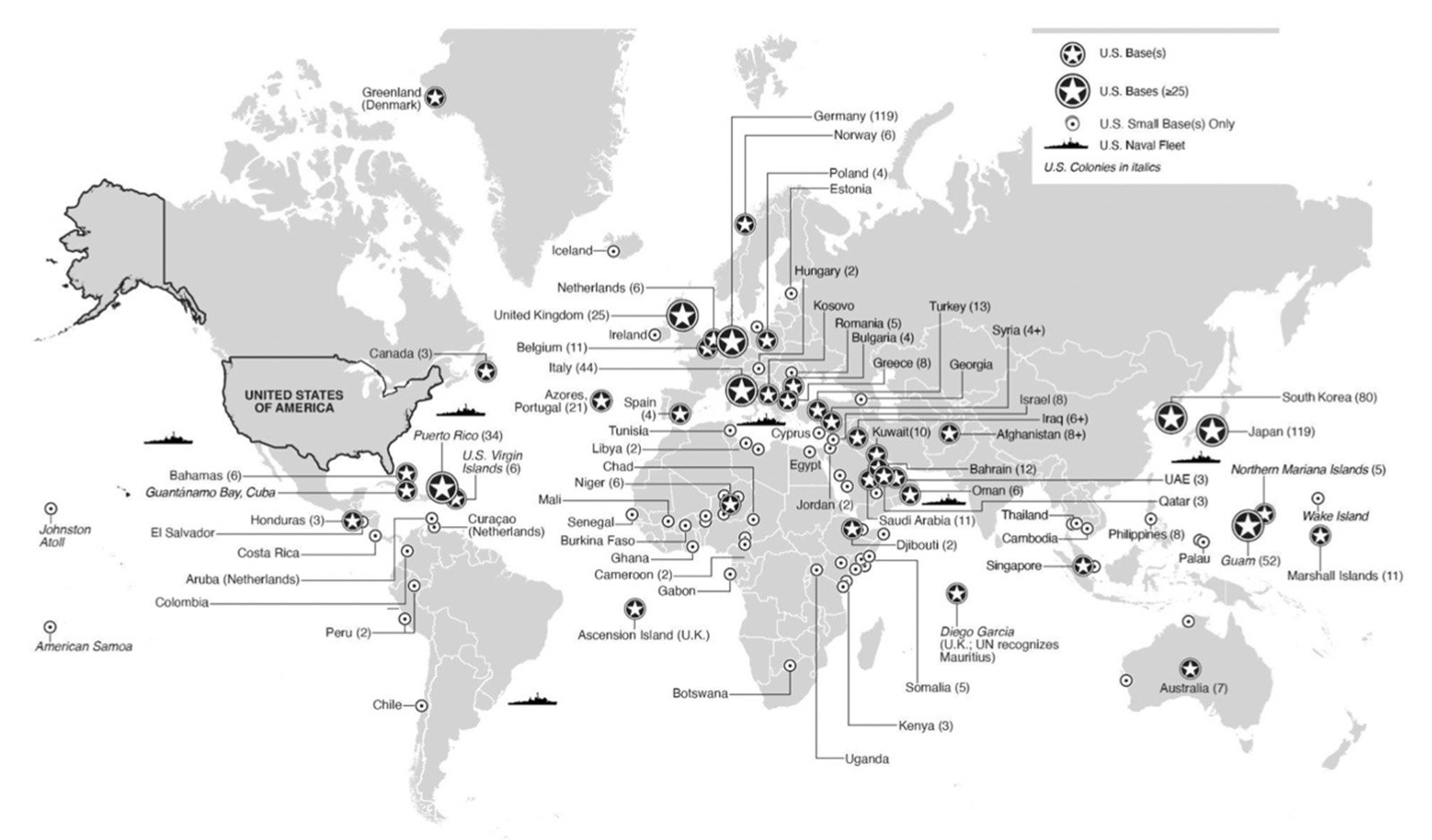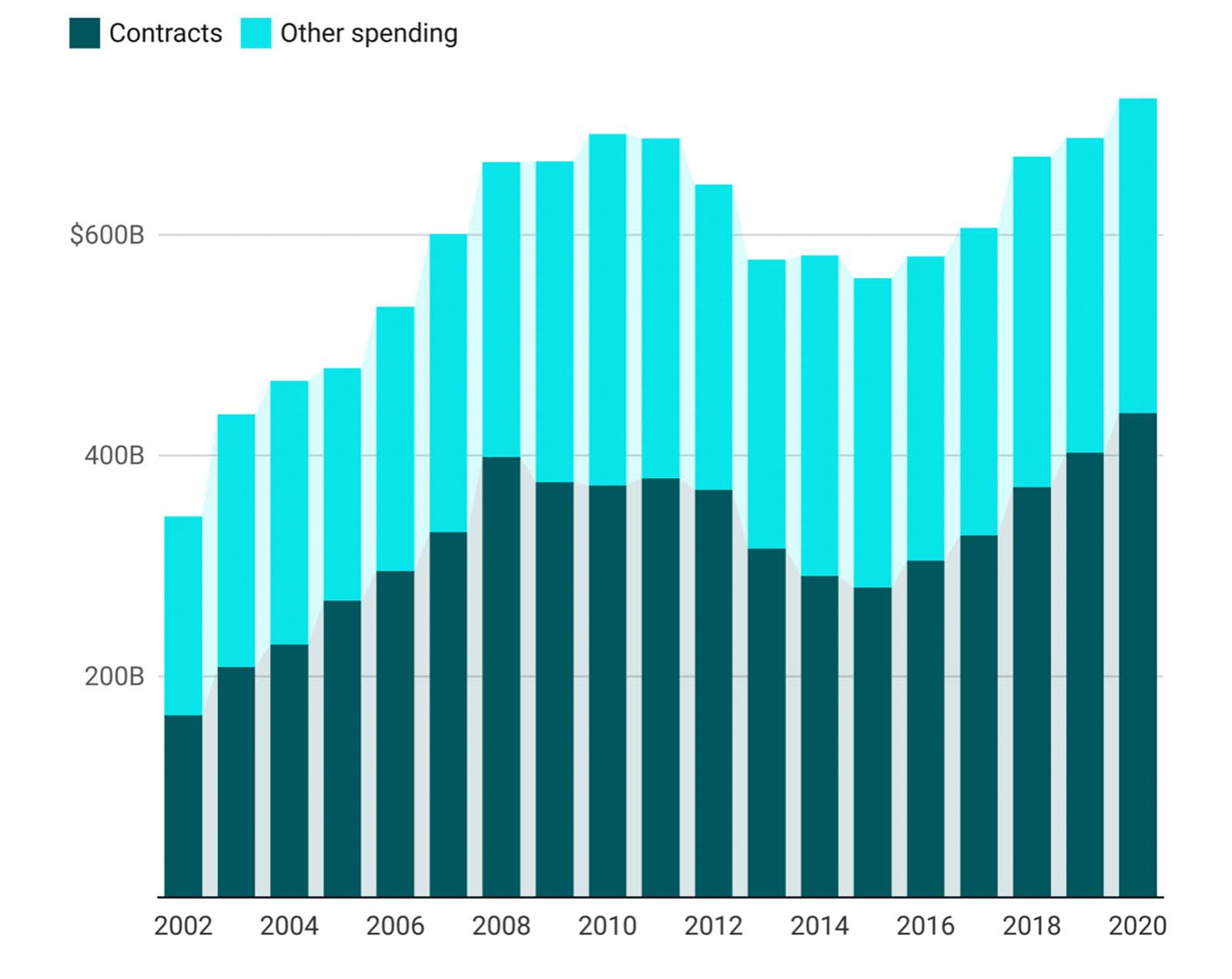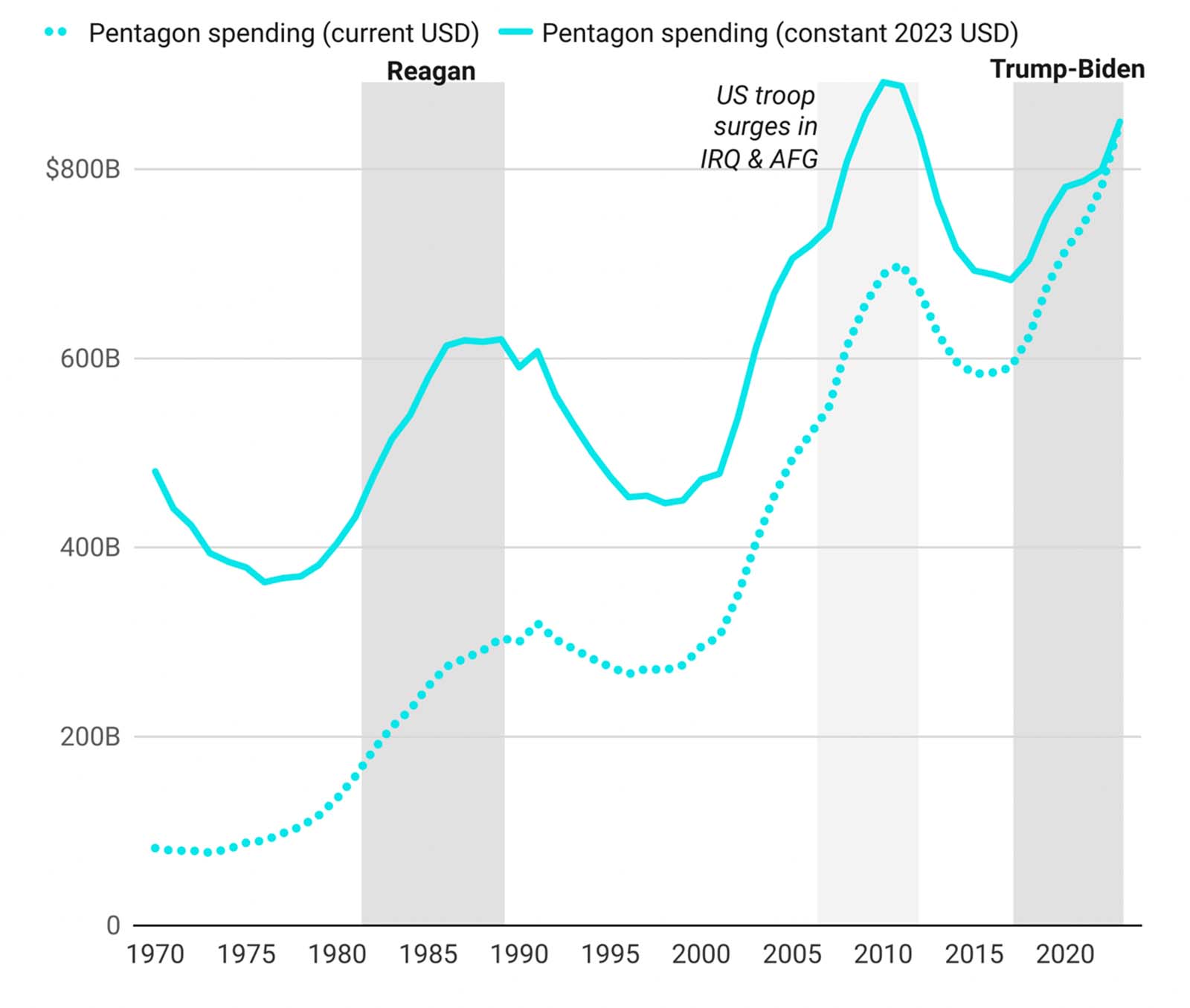The US Military Industrial Complex and the Climate Crisis
UN Secretary-General Antonio Guterres has called for “no exceptions” and “no compromises” at COP28, taking place in Dubai in December 2023. Yet, one glaring exception surrounds military emissions, which continue to be excluded from international reporting requirements although they account for an estimated five and a half percent of global emissions.
Military Emissions: A Glaring Exception
It is increasingly unlikely that the world will stay under the 1.5 degree Celsius benchmark set forth by the Paris Agreement. In light of this collective failure on climate action, UN Secretary-General Antonio Guterres has called for “no exceptions” and “no compromises” at COP28, taking place in Dubai in December 2023. Yet, one glaring exception surrounds military emissions, which continue to be excluded from international reporting requirements although they account for an estimated five and a half percent of global emissions.
The primary beneficiary of this exemption is the United States, by far the largest military spender and historically the largest emitter of greenhouse gases (GHGs). The US government is the largest institutional consumer of fossil fuels, and, thus, the world’s single largest emitter. 70 percent of these emissions come from the military, which generated at least 100 million metric tons in GHG emissions in 2021, more than entire countries including Qatar, Belgium, and Chile. Spending more on its military than the next ten countries combined, with the largest global military presence in human history, the US has been instrumental in ensuring military emissions are exempted from international reporting requirements.
This exemption has real impact. Without comprehensive reporting requirements, a majority of military emissions go uncounted, while the global community falls further behind on its climate goals and vulnerable communities suffer the consequences. Without comprehensive reporting requirements, the world’s single largest institutional emitter is free to publish “climate strategies” and “sustainability reports” without making meaningful changes to the behavior that led to its vast pollution. Without comprehensive reporting requirements, there is no reason to question the constant growth of military spending, which emboldens the profiteers of war as climate finance lags far behind needed levels.
It is time to end the opacity shrouding military emissions and the impunity surrounding military pollution. This starts with stronger international reporting requirements.
The Lack of Reporting Requirements for Military Emissions
In 1997, the Department of Defense (DoD) and military hardliners, with the strong support of US Senators Joe Biden and John Kerry, ensured military emissions were exempt from the annual reporting requirements of the Kyoto Protocol. They argued that “Imposing greenhouse gas emissions limitations on tactical and strategic military systems would… adversely impact operations and readiness.” This early prioritization of military dominance over climate action has constrained reporting requirements to the present day.
Although the Kyoto Protocol was never ratified by the United States, the Intergovernmental Panel on Climate Change (IPCC), to which national emissions are currently reported, still follows the conventions of the Protocol, treating military emissions differently from all other categories. IPCC procedures only count domestic military emissions and allow countries to group these emissions with civilian categories. It does not require countries to report emissions generated at overseas bases, emissions from multilateral operations, and emissions from “bunker fuels” used in international transport. All of this has kept military emissions masked and undercounted, undermining global climate action and accountability.
Even under the 2015 Paris Agreement, reporting military emissions remains voluntary, which allows countries to continue their military pollution with no oversight. Meanwhile, there remain no international or domestic accounting requirements for military emissions related to scope 3 indirect upstream and downstream emissions, including emissions related to wartime destruction, the emissions of independent contractors employed abroad, and the emissions of weapons manufacturers.
Stronger Reporting Requirements Would Expose False Solutions
Although the US Army and Navy have both committed to achieving net-zero by 2050, the DoD as a whole has carefully avoided making that promise. Instead, it has stated that it aims to achieve “significant” reductions in its emissions. Yet, truly “significant” reductions are unlikely given the nature of the problem and the current solutions on the table.
“Installation” energy (energy use at military bases) accounts for roughly 30-35 percent of the DoD’s annual energy consumption. “Operational” energy, on the other hand, i.e. the energy needed to directly support military operations and training, makes up roughly 65-70 percent of DoD’s yearly energy consumption. The US military has highlighted feasible ways to achieve net-zero at installations, including the procurement of microgrids, the electrification of vehicles, and the construction of renewable projects such as expansive solar arrays, but in order to get even close to net-zero by 2050, it would have to drastically reduce its vast operational emissions.
The DoD clears up some questions surrounding how it plans on bridging this gap in its “Plan to Reduce Greenhouse Gas Emissions” published in April 2023. Its plans include the substitution of current fuels with sustainable liquid fuels, increasing the energy efficiency of its aircrafts and vessels, pursuing technology innovation and adoption, and leveraging carbon capture technologies and nature-based sequestration to offset remaining emissions. This glossy language represents a host of far-off, false solutions, such as:
-
Sustainable Aviation Fuels (SAFs), regarding which the DoD admits that, “price and availability barriers currently prevent the Department from purchasing… in operational quantities.”
-
Energy efficient designs that are difficult to adopt given that the US military replaces its ships and aircrafts more slowly than the private sector and concerns that adopting new innovations may undermine mission readiness.
-
Carbon Capture, Utilization, and Storage (CCUS) technologies, which are only in early stages of development and the DoD concedes “may be impractical at scales large enough to be effective” due to “high life cycle costs,” and uncertainties that the technology “could have unintended consequences” or “safety impacts.”
-
Nature-based solutions, which, according to the DoD, involve planting trees to naturally sequester GHG emissions (biosequestration); although, the Department confesses that this “is a highly dynamic process that cannot be assumed to be entirely permanent or steady.” Meanwhile, the US military is moving ahead with plans to bulldoze 1,000 acres of pristine limestone forest in Guam ahead of the construction of a Live Fire Training Range Complex— forest, which, according to the US Fish and Wildlife Service, has some of the greatest biodiversity and carbon sequestration capacity out of the many patches of forest on the island.
Without proper reporting requirements for military emissions, the public has no way of holding the US military accountable to its promise of “significant” emission reductions. Exempted from not only international reporting requirements, but also domestic decarbonization pledges, the world’s single largest institutional emitter has been let off the hook, free to shamelessly greenwash while continuing its destructive practices.

Stronger Reporting Requirements Would Expose the Costs of the United States’ Overwhelming Global Military Presence
Currently, the climate strategies that have come out of the DoD have not only omitted, but entirely ignored the most meaningful way of reducing military emissions— downsizing.
In 2017, the DoD reported it had an excess capacity of 19 percent in military bases. In 2020, US Chairman of the Joint Chiefs of Staff, Mark Milley, stated that the US “has too much military infrastructure overseas.” The DoD openly admitted in its 2023 emissions reduction strategy that “the downward trend in OE (operation energy) associated emissions is largely a product of the gradual reduction in combat operations in Iraq and Afghanistan and the curtailment of collective training in response to the COVID pandemic,” acknowledging that reducing military presence and activities has been the main driver of its emission reductions over the past decade.

Yet, nowhere in its 2023 emissions reduction strategy does the DoD mention a drawdown of its expansive presence, nor do the climate strategies of the individual military departments. Actually, the United States is actively expanding its military presence in several key regions. This expansion overtly contradicts the US military’s commitments to emissions reductions, increasing operational emissions as well as scope 3 emissions and bunker fuel use, which continue to go uncounted. It also undermines environmental justice, which the DoD highlights as a “key enabler” to achieving its climate goals, as the overseas expansion of the US military has long been accompanied by environmental pollution, a concerted lack of respect for local and Indigenous communities, and other forms of societal harm including sexual violence, economic stagnation, human rights abuses, and increased rates of government repression.
As the Pentagon commits to emissions reductions, the most effective step it could take would be to reduce its overwhelming, worldwide presence. Unfortunately, it appears that the opposite is likely to happen, as the US sees climate change as a threat multiplier. In June 2022, the Defense Department's chief sustainability officer and senior advisor for climate stated that “climate change is dramatically increasing the demand for military operations.”
Proper reporting requirements would bring to light the climate cost of the US military’s overwhelming global presence and unchecked expansion. In a system where the US military is not only ignored by emissions reporting requirements, but also frequently exempted from domestic and foreign environmental protections, proper reporting requirements are also the first step towards achieving greater environmental justice.

Stronger Reporting Requirements Hold Accountable the US Military-Industrial Complex; the Profiteers of War
It is estimated that the US military-industrial complex (MIC), comprised of defense contractors and weapons manufacturers, emitted 280 million metric tons of CO2e in 2017. This would mean the DoD’s scope 3 emissions from weapons manufacturing are far from “equal to” and definitely “greater than” the department’s scope 1 and 2 emissions. To mitigate these emissions, the Pentagon plans to enact “buy clean” policies, claiming it will leverage its purchasing power to push for lower embodied GHG emissions as well as consider scope 3 disclosure requirements for large federal contractors.
Yet, there are significant barriers to the effectiveness of these approaches. First of all, over the past two decades, the DoD has been largely unable to control the widespread price gouging and profiteering of its contractors. Since the 1990s, the Pentagon has occupied a top spot on the Government Accountability Office’s high-risk list for financial management, 20 percent of ongoing investigations by the Pentagon’s Office of Inspector General relate to procurement fraud, and the DoD is the only federal agency to never pass any audit.

In the 1990s, there were 51 major defense contractors, but a continuous series of mass mergers in response to post-Cold War spending cuts led these 51 contractors to consolidate into five giants that now dominate the defense industry. According to the Congressional Research Services, these five— Lockheed Martin, Raytheon Technologies, General Dynamics, Boeing, and Northrop Grumman— eat up over 30 percent of contractor outlays each year, and produce at least 74 percent of the major weapons systems purchased by the US government. In a May, 2023 letter, five senators expressed their growing concern over the power wielded by these defense giants, writing that they had, “abused the trust government has placed in them, exploiting their position as the sole suppliers for certain items.” Their oligopoly over the defense production and immense political influence has long kept lawmakers from being able to push back against their financial deceit, a fact that erodes any confidence one might have in the Pentagon’s newest plan to “leverage its purchasing power” to push these contractors to reduce embodied emissions.
Scope 3 disclosure requirements face similar hurdles. If the Pentagon is unable or unwilling to hold its contractors accountable when it comes to its own money, how can it be expected to hold them accountable for their scope 3 emissions? Members of US Congress who benefit economically from the MIC make matters more difficult and have already taken action to gut scope 3 disclosure requirements. Even in a best case-scenario where the requirements are passed, standardized, and enforced, such a rule would only require large contractors to divulge and set science-based targets, without having to necessarily abide by them.
Current international reporting requirements for military emissions leave the contributions of US military contractors in the dark. These contractors receive almost all of their revenues from governments contracts, foreign and domestic, and have a vast set of tools at their disposal to exert influence on Capitol Hill. This enables a distinctly undemocratic process where decisions that impact climate, environment, and the lives of billions around the world are left to the profiteers of war. Better international reporting requirements that hold militaries responsible for the emissions of their contractors are sorely needed, especially as increased military spending stemming from conflicts in Ukraine, the Middle East, and geopolitical competition with China further enhances the power of special interests within the MIC.

What is at stake?
2023 has already been marked by a series of historic climate disasters affecting every continent. In the US alone, 80 million people have been affected by severe heatwaves and wildfire smoke, the hottest temperature ever was recorded in California, and Hawaii experienced the deadliest wildfires in modern US history. Ahead of COP28 and the Global Stocktake, a synthesis report by the IPCC has stressed that the window to secure a “livable and sustainable future for all” is rapidly closing.
Meanwhile, our research into US military emissions highlighted several points:
-
Current international reporting requirements for military emissions are extremely opaque and resoundingly incomplete.
-
The climate strategies of the US military, the world’s single largest institutional emitter, are flawed. They do not provide a clear path toward net zero, and emphasize distant and false solutions for reducing the majority of their emissions.
-
The US military omits the most important emission reductions strategy of all from its climate plans— downsizing. Instead, it looks toward further global expansion, despite expert assessments that the US military is overextended and the added risks to environment and human safety this poses.
-
Defense contractors, who likely emit more than the US military itself, wield enough power over US government that they have long avoided any form of accountability. They actively promote military expansion and aggression, even when it is unnecessary, because they profit from every dollar added to the annual defense budget.
These dynamics not only undermine climate action where they allow the world’s largest institutional emitter to go unchecked in the face of increasingly destructive and frequent climate events, they also subvert progress in more subtle ways.
A 2018 report from Rand, a leading institution in defense research, found that a large US military presence overseas was associated with a higher likelihood of the US initiating militarized disputes. Indeed, research from the Congressional Research Service documents that over the past 30 years, the US has engaged more military interventions than in the first 190 years of its existence. Even if the US military does manage to significantly reduce its emissions, its continued expansion increases the chances of future conflict, which would inevitably drive scope 3 military emissions from wartime destruction and defense contractors upwards.
Additionally, US military growth in terms of budget and reach tends to drive the expansion of foreign militaries belonging to both allies and adversaries. With the number of military alliances increasing, friends of the US are expected to contribute more significantly to defense partnerships, and often increase their own military spending, activities, and multilateral operations. In turn, US military expansion drives adversaries to increase the scope, reach, and activities of their own militaries in order to “counter balance” the perceived threat. Thus, the growth of the US military’s presence and resource consumption drives global military emissions upwards, regardless of its own efforts to “decarbonize.”

Finally, and most importantly, US defense spending eats up almost 50 percent of the federal budget each year, taking resources away from less destructive, more productive pursuits. In 2020, Lockheed Martin received US$70 billion in Pentagon contracts, more than the budgets of the US Department of State and Agency for International Development combined. Spending significantly more on defense than diplomacy and development increases US reliance on carbon-intensive military intervention as a tool to advance its interests abroad. Meanwhile, the US continues to fall behind on climate finance along with the rest of the world’s richest countries. For fiscal year 2023, the US approved a breathtaking defense budget of US$816 billion, while only appropriating US$1 billion in direct climate finance. Collectively, between 2013 and 2021, the world’s 30 richest countries have spent 30 times more on their militaries than on climate finance, continually falling short on climate related needs.
Communities across the globe continue to suffer at the hands of US military pollution every day. They suffer both directly and indirectly, as chemicals contaminants from US bases invade their environments and bodies; as their ecosystems and cultural sites are destroyed by training exercises, hazardous waste disposal, and military construction; as military emissions contribute to climate change; as billions in climate finance are lost to defense; and as peace and stability are undermined by the further militarization of US foreign policy. The public deserves, and must demand, the power to hold militaries accountable for their contributions to environmental destruction, to the climate crisis, and to human hardship. This begins, but certainly does not end, with comprehensive and transparent reporting requirements for military emissions.
